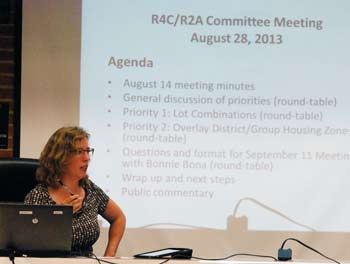R4C/R2A Committee Focuses Its Work
Ann Arbor R4C/R2A advisory committee meeting (Aug. 28, 2013): At its second of four meetings since being reconstituted by the city council this summer, the committee tasked with giving advice on possible changes to the R4C/R2A residential zoning districts moved closer to prioritizing final recommendations to deliver to the planning commission and city council.

Julie Weatherbee is chair of the R4C/R2A advisory committee, which met most recently on Aug. 28, 2013. The next meeting is scheduled for Sept. 11. (Photos by the writer.)
Two main priorities have emerged as areas of concern: lot combinations, and a proposed “group housing” overlay district. Parking is also a concern, but several committee members noted that there isn’t time to reach consensus about parking recommendations. Only two more two-hour meetings are scheduled – on Sept. 11 and Sept. 25.
The committee’s original report had recommended imposing a maximum lot size of 6,525 square feet. This would limit the ability of a developer to combine lots in order to build larger structures. It would be a way to limit the size of developments within R4C districts.
The planning commission’s ordinance revisions committee made a different recommendation, however, which was adopted by the full commission. Rather than requiring a specific lot size limit, lot combinations would be approved on a case-by-case basis. Review standards would be developed, as well as standards for design and massing, to ensure that new development is compatible with the neighborhood. The planning commission has not yet developed details of how what standards would be used. Advisory committee members didn’t like this approach, saying that it seemed too arbitrary.
There are even fewer details at this point about a proposed group housing district, which planning commissioners envision as a future phase of R4C ordinance revisions. The planning commission recommendations call for a new zoning overlay district, located south and west of the University of Michigan’s central campus. It would be roughly an area outlined in the city’s Central Area Plan, but with final boundaries to be determined. [.pdf of Central Area Plan] The idea is to address issues that are somewhat unique to neighborhoods with a large amount of student housing.
In general, the new district would be intended to allow for flexibility by putting limits on density, but with premiums provided in exchange for community benefits such as pedestrian-friendly character and conformance with architectural design standards. For example, parking might be based on a building’s total floor-area ratio (FAR), independent of the number of units in a structure. The commission’s recommendations call for details of this new district to be fleshed out in a second phase, after other ordinance changes are made that are seen as more straightforward.
Advisory committee members were extremely skeptical of this approach, which one member characterized as “redlining.” Targeting housing for a particular type of resident – in this case, students – made many members uncomfortable. There was also uncertainty about the exact intention behind the recommendation.
Committee members have invited planning commissioner Bonnie Bona, who also serves on the commission’s ordinance revisions committee, to attend their Sept. 11 meeting. Their hope is to get clarity about the commission’s recommendations, as well as the intent behind those recommendations.
Several committee members stated that their overarching goal is to protect the character and integrity of existing neighborhoods, and to prevent older houses from being demolished. That’s the scenario that unfolded when seven houses were torn down along South Fifth Avenue to make way for the City Place apartments – a controversial development that was part of the impetus for the R4C/R2A review. [Full Story]



